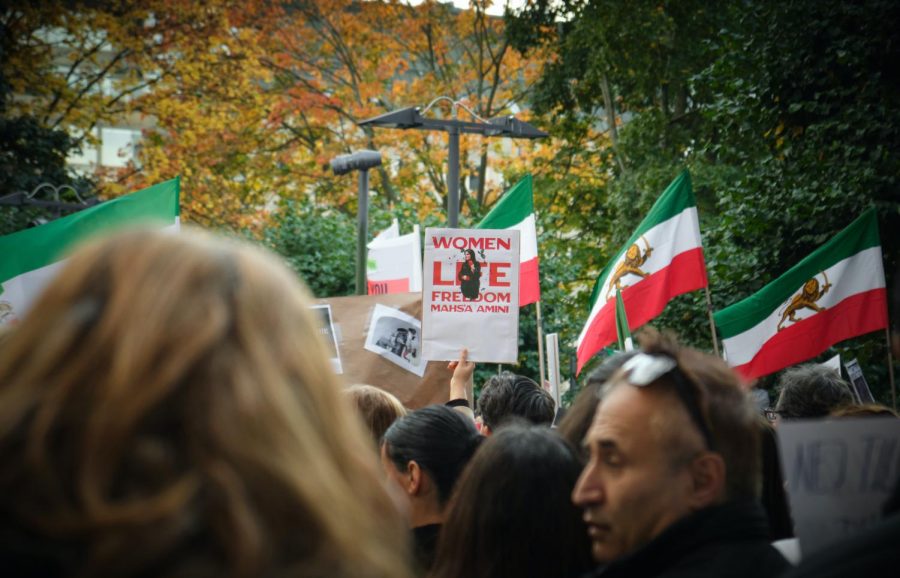Continuing the Fight For Human Rights in Iran
Protests against Iranian authority are present in Sweden, among other nations.
November 16, 2022
*The opinions expressed within the content are solely the author’s and do not reflect the opinions and beliefs of the website or its affiliates.*
Imagine one day you wake up and discover that all of your basic rights are stripped away from you. In an instant, you lose your ability to express yourself, influence change in your nation, choose what to wear and be who you want to be. In 1979, this happened to the Iranian citizens when their whole reality changed. Their beloved shah, Mohammad Reza Pahlavi, was overthrown by the Islamic Republic on Feb. 11, 1979. With his downfall, Iran’s 2,500-year-old monarchy came to an end, and Ayatollah Khomeini’s theocracy took its place. On the same day, the Iranian citizens’ human rights were taken away from them.
The Iranian people were against the concept of an Islamic Republic, voicing their opposition to this change that same year. This new Islamic Republic that would oppress its citizens at home and wield authority far beyond its boundaries was opposed by the majority of the population. The regime would renounce its commitment to upholding human rights and regularly discriminate against and brutally treat minorities of all kinds, including women, children and members of the LGBTQ community. Following the onset of their oppression by these heinous acts, many Iranian citizens fled the nation. For a new life for themselves and their future generations, they left everything behind. However, a sizable portion of the Iranian population continued to stay since, financially, they had no other option.
The Islamic Republic’s ruthless treatment of its citizenry after the revolution has not previously been openly contested by the world. Iran’s populace responded to a brutal deed against a young woman by taking action. Iranian Kurdish woman Mahsa Amini, 22, passed away on Sept. 16, 2022, while she was being held by the police. The morality police in Iran detained Ms. Amini for allegedly wearing her hijab incorrectly, but it was unclear exactly how she had transgressed the nation’s Islamic dress codes. The anger that erupted after Masha Amini’s passing caught the Iranian government off guard. Iran’s people felt it was time to reform the nation because they were sick of its authoritarian and repressive government.
Even though this uprising against the Iranian regime took place more than 40 years ago, the younger generation has rightfully taken charge. Compared to their parents and grandparents, who were severely restrained by conservative social forces and the ruling system’s censorship during the 1980s and 1990s, Iran’s younger generation has had greater access to knowledge and the outside world. Their participation in and access to online social media has given them better analytical skills, a platform to voice their concerns and the courage to speak up. Additionally, the younger generation is aware of what life might be like without the Islamic Republic, as they can gain insight from other nations throughout the world that are not obligated to abide by these strict regulations.
Sixteen-year-old Iranian citizen Niloufar Pourghasemi explained her views on why she felt she needed to help protest in Iran.
“I was so tired of seeing my little sister scared to go outside of the house,” Pourghasemi said. “She was scared that the police would take her. Living in fear of her life was not the way I wanted to see her. I wanted to protect her and I knew this needed to stop.”
The rising protests serve as a necessary step towards positive change against the tyrannical Iranian government. Since Sept. 16, protests have broken out in several Iranian towns and, despite stringent internet control, have drawn attention from around the world via social media. Many of the protesting women are taking off or burning their headscarves, which have been mandated for women since the 1979 revolution. Some women have started chopping their hair. Haircuts are significant in Iranian culture because, in ancient Persian literature, they represented anger, despair and disapproval.
Those opposed to the country’s hijab laws, in protest of Amini’s passing and in support of Iranian women have marched from the Middle East to Europe and the United States. The cause has gained traction and been shared globally. If other nations support the Iranian citizens, the Iranian regime loses authority over its populace. This encourages the people of Iran to continue fighting for their rights and standing up for what they believe in because change will eventually come about.
UHS sophomore Rodin Behravani expressed his views as to why he supports the protests going on and bringing change to Iran.
“Even though I am a guy, I still fight for the women in Iran to have the freedom to wear what they want, and not to be forced to wear a headscarf if they do not want to,” Behravani said. “My parents came here at a young age to have a better life and escape from what was happening. I hope that the change needed in Iran can happen.”
However, many oppose the protests and believe that they are disrespectful to Islam. But, such beliefs are unbased. The majority of adherents chose their religion voluntarily and concluded that the Islamic principles were ones they agreed with. Therefore, it should be up to that person to decide how religious they wish to be. If a woman in Iran does not wish to practice or believe in that particular religion, she should not be required to wear a headscarf. Ultimately, everything should be up to her to decide.
Millions of Iranians are currently battling for their fundamental human rights. They are unsure if they will return from protesting due to these horrible conditions. Regardless, they are acting by their convictions and moral standards, which has led people from all over the world to support these courageous individuals. High school students should therefore do their best to share the cause and motivate them in their struggle.





